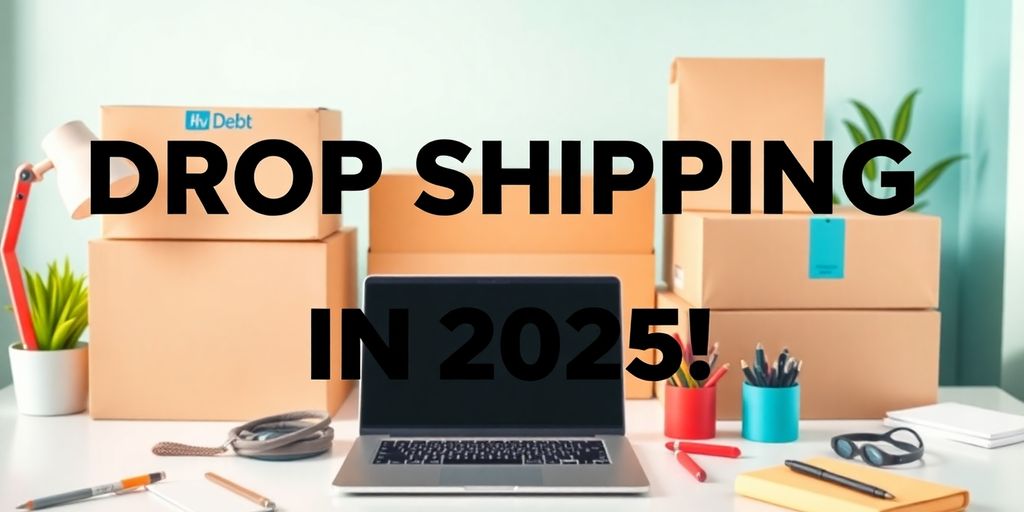Ever thought about jumping into the drop shipping game? It's a business model that's been around for a while but continues to evolve. As we look ahead to 2025, there are some seriously cool examples of how folks are making it work. Whether you're new to the scene or a seasoned pro, there's always something fresh to learn. Let's dive into how you can find your niche, leverage tech, and overcome the usual hurdles to make your drop shipping venture a success.
Key Takeaways
- Understand the basics of drop shipping to get started effectively.
- Identify a niche that isn't overcrowded to stand out.
- Use automation and AI tools to streamline your operations.
- Build strong relationships with reliable suppliers.
- Adopt innovative marketing strategies to grow your business.
Understanding the Basics of Drop Shipping
What is Drop Shipping?
Alright, let's break it down. Drop shipping is like running a store without the hassle of keeping products in your garage. You set up an online shop, list products, and when someone buys something, a third party ships it directly to them. No stock, no shipping nightmares. Sounds easy, right? But remember, since you’re not handling the products, quality control can be a bit tricky.
How Drop Shipping Works
Here's the scoop:
- You pick a product and list it on your online store.
- A customer places an order.
- You forward the order to your supplier.
- The supplier ships the product straight to your customer.
Simple as pie! But here’s the catch: you rely heavily on your suppliers, so picking reliable ones is key.
Benefits of Drop Shipping
Why is everyone buzzing about drop shipping? Well, it’s because:
- Low Startup Costs: You don’t need a warehouse full of products.
- Flexibility: Work from anywhere; all you need is a laptop and internet.
- Wide Product Range: You can offer a variety of products without worrying about storage.
"Drop shipping is a way to test new products without the risk of buying in bulk. Just make sure your suppliers are top-notch to keep your customers happy."
For those looking to begin dropshipping on Shopify, there are simple methods tailored to different levels of experience and goals.
Finding Your Niche in Drop Shipping

Identifying Profitable Niches
Figuring out the right niche for your drop shipping business is like finding the perfect pair of jeans—it takes some trial and error, but once you find it, everything just clicks. Start by diving into market research to see what’s hot and what’s not. Use tools like Ahrefs or SEMrush to spot trending products that aren't overly saturated. The goal is to find a sweet spot where demand is high, but competition is manageable.
- Look for products that solve a problem or meet a need.
- Consider your own interests and passions; they can give you an edge.
- Check out what's selling well globally and locally—sometimes the best niches are right under your nose.
Researching Market Trends
Keeping up with market trends is like staying ahead of the fashion game—you don’t want to be caught wearing last season’s styles. Google Trends is your friend here. It can show you whether your potential niche is on the rise or fizzling out. Also, follow industry news and reports to stay informed about shifts in consumer behavior.
- Use Google Trends to track interest over time.
- Subscribe to industry newsletters for regular updates.
- Join forums and online communities to hear directly from consumers.
Staying on top of trends not only helps you pick the right products but also keeps your business agile and responsive to change.
Avoiding Overcrowded Markets
Nobody wants to be a small fish in a big pond, right? That’s why you should steer clear of overly crowded markets. If you’re seeing the same product everywhere, it might be time to think outside the box. Look for niche markets that are underserved or have unique needs that aren’t being met by the big players.
- Analyze competitors to see what they’re doing and where they might be falling short.
- Find gaps in the market where you can offer something different.
- Consider niche markets that are emerging or have fewer competitors.
In the end, finding your niche is all about balancing your interests with market demand, and being ready to adapt as trends evolve. Happy niche hunting!
Leveraging Technology for Drop Shipping Success
Automation Tools to Streamline Operations
Running a drop shipping business can be a bit like juggling flaming swords—exciting but also a bit risky if you're not careful. Thankfully, automation tools are here to save the day. Tools like AutoDS take care of the nitty-gritty, from importing products to keeping track of prices. This means you can focus on what really matters: growing your business.
Here's how automation can help:
- Product Importing: Automatically import products from suppliers to your store, saving time and reducing errors.
- Price Monitoring: Keep an eye on price changes and adjust your listings automatically to stay competitive.
- Order Fulfillment: Automate order processing to ensure quick and accurate deliveries to your customers.
With automation, you have more time to think big and plan your next move instead of getting bogged down in daily tasks.
Using AI to Predict Trends
Artificial Intelligence (AI) is like having a crystal ball for your business. By analyzing heaps of data, AI can help you spot trends before they become mainstream. This means you can stock up on products that are about to take off, giving you a leg up on the competition.
- Trend Analysis: AI tools can analyze social media trends, search data, and more to predict what's hot.
- Customer Insights: Understand your customers better and tailor your offerings to suit their needs.
- Inventory Management: Predict demand and manage stock levels to avoid overstocking or running out.
AI and automation are expected to be game-changers in the drop shipping world by 2025.
Integrating with E-commerce Platforms
Getting your drop shipping business to play nice with e-commerce platforms is crucial. Whether you're using Shopify, WooCommerce, or another platform, integration is key to smooth operations.
- Seamless Syncing: Ensure your inventory and orders are synced across all platforms to avoid mishaps.
- Payment Processing: Integrate with payment gateways to provide a secure and smooth checkout experience.
- Customer Management: Use CRM tools to keep track of customer interactions and improve service.
By making the most of these technologies, you're setting yourself up for success. Remember, the key is to keep learning and adapting to new tools and trends as they emerge. Happy drop shipping!
Building Strong Supplier Relationships
Choosing Reliable Suppliers
First things first, you gotta find suppliers you can actually rely on. This is super important because your business basically depends on them. Imagine your supplier flaking out—nightmare, right? Look for suppliers with a good track record, maybe check out reviews or ask around in drop shipping communities. A supplier with at least a couple of years in the business is usually a safer bet.
Here's a quick checklist:
- Minimum order quantities: Make sure they align with your business needs.
- Shipping time: Faster is better, keeps customers happy.
- Product quality: You want to offer the best to build trust.
- Experience: At least one or two years in dropshipping.
- Customer support: They should be easy to reach and helpful.
Negotiating Better Terms
Negotiating with suppliers can be a bit nerve-wracking, but it's something you gotta do. You want to score better prices or terms that work in your favor. Don't hesitate to ask for discounts, especially if you're buying in bulk. It’s also a good idea to talk about payment terms and see if you can get some flexibility there.
Ensuring Product Quality
Now let's talk quality. You want to make sure your products are top-notch. This means you might need to order samples before you commit to a supplier. Check the materials, the build, and even the packaging. A good product not only satisfies your customers but also helps you avoid returns and negative reviews.
Building strong supplier relationships takes time and effort, but it’s totally worth it. A reliable supplier can make your drop shipping journey a lot smoother and more successful.
Marketing Strategies to Boost Your Drop Shipping Business
Utilizing Social Media Marketing
Social media is your best friend when it comes to marketing your drop shipping business. It's where your customers hang out, share, and shop. To make the most of it, you should:
- Engage regularly: Post regularly and interact with your audience. Answer their questions, comment on their posts, and build a community.
- Use visuals: Eye-catching images and videos grab attention. Think about showcasing your products in use or creating short, engaging clips.
- Run targeted ads: Platforms like Facebook and Instagram offer powerful targeting tools. You can reach specific demographics who are more likely to be interested in your products.
Social media isn't just about posting pretty pictures. It's about creating a conversation and building a brand that people can relate to.
SEO Tips for Drop Shipping
Search Engine Optimization (SEO) is crucial for getting your drop shipping store noticed. Here’s how you can improve your SEO:
- Keyword research: Identify the phrases your potential customers use when searching for products like yours. Use these keywords naturally in your product descriptions and blog posts.
- Optimize product pages: Ensure each product page is optimized with relevant keywords, meta descriptions, and alt tags for images.
- Create quality content: Regularly publish blog posts or guides related to your products. This not only helps with SEO but also positions you as an expert in your niche.
SEO might seem daunting, but it's all about making your store more visible to people who are already looking for what you’re selling.
Email Marketing Campaigns
Email marketing is a powerful tool for keeping in touch with your customers and encouraging repeat business. To make it work for you:
- Build a list: Encourage website visitors to sign up for your newsletter. Offer a discount or free shipping on their first order as an incentive.
- Segment your audience: Tailor your emails to different segments of your audience. Send personalized recommendations based on past purchases or browsing behavior.
- Automate campaigns: Set up automated emails for cart abandonment, welcome series, and post-purchase follow-ups.
Email marketing is not about spamming people’s inboxes. It's about delivering value and building a relationship with your customers.
Remember, effective dropshipping marketing strategies include promoting new arrivals and sales to generate excitement. Creating buzz before product launches and implementing limited-time promotions can instill urgency and attract customers. Effective dropshipping marketing strategies can make a big difference in your business's success.
By focusing on these strategies, you'll be well on your way to boosting your drop shipping business and connecting with your audience in meaningful ways.
Overcoming Common Drop Shipping Challenges
Dealing with Low Profit Margins
In the world of drop shipping, low profit margins are a common hurdle. The key is to find ways to maximize each sale. Here are a few strategies to consider:
- Upselling and Cross-Selling: Encourage customers to purchase additional items by offering bundles or suggesting complementary products.
- Negotiate with Suppliers: Try to secure better pricing terms with your suppliers to reduce costs.
- Optimize Ad Spend: Focus on performance-based advertising to ensure every dollar spent is effective.
Managing Customer Expectations
Setting clear expectations with your customers can prevent a lot of headaches. Here's how to keep them happy:
- Transparent Communication: Clearly communicate shipping times and potential delays during checkout.
- Regular Updates: Keep your customers informed about their order status with regular updates.
- Customer Support: Provide excellent customer service to address any concerns quickly.
Handling Shipping Delays
Shipping delays can damage your reputation if not handled properly. Here's how to mitigate the impact:
- Work with Local Suppliers: Partner with suppliers who have warehouses closer to your target market.
- Set Clear Expectations: Inform customers about potential delays upfront and during order confirmation.
- Have a Backup Plan: Always have alternative suppliers or shipping methods ready to go in case of disruptions.
Remember, the art of drop shipping involves mastering the balance between cost, quality, and customer satisfaction. By addressing these challenges head-on, you can build a more resilient and successful business.
Innovative Drop Shipping Examples for 2025
Case Studies of Successful Businesses
Ever wondered how some drop shipping businesses just seem to nail it while others struggle? Let’s dig into some real-world examples of those who are killing it in 2025. Picture a company that’s focused on profitable dropshipping niches like eco-friendly products. They’ve tapped into the growing trend of sustainability, offering items like biodegradable phone cases and reusable kitchen supplies. By aligning with consumer values, they've built a loyal customer base.
Unique Product Offerings
When it comes to standing out, having a unique product line is key. Think about a drop shipping store that specializes in quirky, custom-designed home decor items. These aren't just your run-of-the-mill products; they’re conversation starters. Customers love the idea of having something exclusive, and this uniqueness can drive word-of-mouth marketing like nothing else.
- Customizable Products: Offering personalization options can make products feel special.
- Limited Editions: Create urgency and exclusivity with limited-time offers.
- Eco-Friendly Choices: More consumers are looking for sustainable options.
Creative Branding Strategies
Branding isn’t just about a logo or color scheme; it’s about the whole vibe of your store. Imagine a drop shipping business that’s built its brand around a fun, adventurous lifestyle. Everything from their product descriptions to their social media posts reflects this theme. They use storytelling to connect with their audience, making their brand memorable.
Branding is your chance to tell a story that resonates with your audience. It’s not just about selling products; it’s about selling an experience.
By focusing on these innovative strategies, you can set your drop shipping business apart from the competition. Whether it's through unique products or clever branding, the opportunities in 2025 are endless.
The Future of Drop Shipping: Trends to Watch

Sustainability in Drop Shipping
Alright, let's talk about going green. More and more customers are looking for eco-friendly options, so why not give them what they want? You can make your business stand out by offering sustainable products or using recyclable packaging. It's not just about saving the planet; it's also about making your brand more attractive to the environmentally conscious crowd. Plus, as the global dropshipping market continues to grow, tapping into this trend could be a game-changer.
The Rise of Personalization
In 2025, personalization is the name of the game. Customers want products that feel like they were made just for them. Think about offering customization options or personalized recommendations based on browsing history. This can create a more engaging shopping experience and keep your customers coming back for more. It's like having a personal shopper, but way cooler.
Expanding to Global Markets
Why limit yourself to one region when you can take over the world? Expanding your drop shipping business globally can open up new revenue streams and reduce risks associated with relying on a single market. However, be prepared to tackle challenges like different regulations, shipping logistics, and cultural preferences. It might sound daunting, but with the right strategy, you can make it work. Going global isn't just a dream—it's a smart move for future growth.
Embracing these trends isn't just about keeping up; it's about leading the way in an ever-evolving industry. By focusing on sustainability, personalization, and global expansion, you're setting your business up for success in 2025 and beyond.
As we look ahead, the world of drop shipping is changing fast. New trends are emerging that can help businesses grow and succeed. From using advanced technology to better understand customers to finding unique products that stand out, there are many exciting opportunities. If you're interested in learning more about how to take advantage of these trends, visit our website for helpful tips and resources!
Wrapping It Up: Your Roadmap to Dropshipping Success in 2025
Alright, so we've covered a lot of ground here. Dropshipping in 2025 is shaping up to be a wild ride, but with the right moves, you can totally make it work. The key? Stay flexible and keep an eye on trends. Whether it's tapping into niche markets or using smart upselling strategies, there's plenty of room to grow. Remember, it's not just about picking the right products but also about creating a shopping experience that keeps folks coming back. So, dive in, experiment, and don't be afraid to tweak your approach as you go. You've got this!
Frequently Asked Questions
What is drop shipping?
Drop shipping is a way to sell things online without keeping them in stock. When someone buys from your store, you order the product from a supplier who ships it directly to the buyer.
How does drop shipping work?
When a customer orders from your online store, you forward the order to a supplier. The supplier then packs and ships the product straight to the customer.
What are the benefits of drop shipping?
Drop shipping lets you start an online store without needing to buy or store inventory. It also means you can offer a wide range of products with less risk.
How can I find a profitable niche for drop shipping?
Look for products that are in demand but not too competitive. Research market trends and customer needs to find a niche that interests you and has potential.
What are some challenges in drop shipping?
Common challenges include low profit margins, managing customer expectations, and dealing with shipping delays. It's important to choose reliable suppliers and set clear expectations with customers.
How can technology help in drop shipping?
Technology can help automate tasks like order processing and inventory management. Tools like AI can predict trends, and integrating with e-commerce platforms can streamline your operations.


